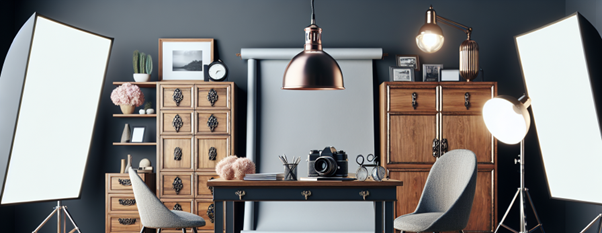Thursday, August 22, 2024
How to Safeguard Your Interests While Renting a Photography Studio
 Article submitted by our commercial partners at Harvard Western Insurance. In the world of visual storytelling, securing the right photography studio can transform your creative vision into reality. However, the complexities of studio rentals—navigating lease agreements, ensuring adequate protection against unforeseen mishaps, and mitigating common rental issues—often pose daunting challenges.
Article submitted by our commercial partners at Harvard Western Insurance. In the world of visual storytelling, securing the right photography studio can transform your creative vision into reality. However, the complexities of studio rentals—navigating lease agreements, ensuring adequate protection against unforeseen mishaps, and mitigating common rental issues—often pose daunting challenges.
Whether you are an experienced photographer or just venturing into the realm of professional shoots, understanding how to safeguard your interests while renting a photography studio is crucial.
Reviewing the Lease Agreement
Key Clauses to Look Out For:
When renting a photography studio, thoroughly reviewing the lease agreement is paramount to safeguard your interests and ensure the space meets your specific needs. Pay close attention to clauses related to the lease's duration, the rent amount, and any provisions for rent increases.
Check for clauses regarding the termination of the lease—understand under what conditions you or the landlord can terminate the agreement and any penalties involved.
Right to Remodel
Before making any modifications to accommodate your photography needs, such as installing heavy blackout blinds or creating a wet space for food photography, ensure the lease permits such alterations. Some leases may allow minor modifications, while others might require landlord approval for any changes.
Understanding Restrictions & Seeking Permissions
Be aware of any restrictions that could impact your photography sessions. This includes limitations on noise levels, access hours, and the use of certain types of equipment.
When it comes to incorporating props and set materials into the equation, things become a bit more complex beyond just a camera and tripod.
To determine whether or not you should seek authorization from the building owner prior to your shoot, professional photographer Chase Jarvis suggests asking yourself the following questions. If you answer yes to at least one of them, it is likely something you should discuss the situation with the building owner:
- Is this a commercial shoot?
- Will your filming activity disrupt traffic into the building?
- Will you need to utilize dollies, wires, generators, or other large equipment?
- Are you using the space in a unique or unconventional manner?
Discussing these aspects beforehand can prevent legal complications or breach of lease agreements and ensure that your shoot proceeds smoothly without interruptions.
Ensuring Adequate Insurance Coverage
Ensuring your photography studio has adequate insurance coverage is crucial for safeguarding your financial and professional interests. Here’s a breakdown of essential considerations:
General Liability Insurance
General liability insurance is essential for photographers utilizing a studio space. It covers claims related to bodily injuries, property damage, and personal injuries that might occur on the premises.
Protecting your assets and reputation is crucial in today's competitive business environment. Liability insurance acts as a safety net for your business by covering financial losses if a client or third party sues you for negligence. This can safeguard your business finances from unexpected legal costs and judgments. Moreover, having liability insurance demonstrates professionalism and builds trust with clients, as they know they are protected if something goes wrong.
Here's an example of a liability that could occur in a photographer's studio:
Scenario: A photographer is conducting a children's portrait session. During the shoot, the photographer sets up a play area with some props, including a small stool. While the photographer is capturing close-up shots of another child, a young child climbs on the stool and loses their balance. The child falls and breaks their arm.
Potential Liability: The child's parents could argue that the photographer was negligent in not properly supervising the children or in creating an unsafe environment with the stool. They might file a lawsuit against the photographer to cover the child's medical bills and other damages.
This situation highlights the importance of having liability insurance. The insurance could help cover the legal costs associated with the lawsuit and any potential settlement awarded to the family.
Adding the Studio Owner as an Insured
It is advisable to include the studio owner as an additional insured on your policy. Lease agreements often require this step to help protect both you and the studio owner under your policy umbrella, minimizing potential legal complications if accidents occur on the property.
Preparing for Common Issues
Emergency Plans
Preparing for unexpected situations when renting a photography studio is vital. Establish a clear emergency plan that addresses potential issues such as power outages, equipment failures, or severe weather conditions. Ensure that both you and your team are familiar with the nearest exits and emergency contact numbers. Additionally, having a first-aid kit and knowing basic first aid can be crucial in managing any accidents promptly.
Identifying Potential Hazards
When you step into a photography studio, your first task is to survey the space for potential hazards. This includes checking for loose wires that could trip someone, unstable lighting setups, or any other unsafe conditions. Assessing these risks is crucial to preventing accidents and ensuring a safe working environment for everyone involved.
Documenting Existing Damage
Before you finalize your studio rental, conduct a detailed inspection of the premises. Look for any signs of existing damage, such as scratches on the floors, dents in the walls, or malfunctioning equipment. Document these imperfections with photographs and notify the studio owner. This documentation will protect you from liability for damages you didn't cause and will be essential if disputes arise later.
Maintaining Communication with the Owner
Effective communication with the studio owner is key to resolving issues swiftly. Regular updates about the studio's condition and any arising concerns can prevent misunderstandings and foster a positive rental experience. If modifications or repairs are needed, discussing them with the owner beforehand can help ensure that actions are approved and aligned with your lease agreements.
Conclusion
Understanding your lease, securing the proper insurance, and maintaining open lines of communication cannot be overstated, as these elements are crucial for a successful and hassle-free studio rental experience.
The insights shared reflect a broader understanding of the professional photography landscape, emphasizing the meticulous attention to detail necessary when entering rental agreements and the proactive measures needed to mitigate risks. As we conclude, remember that the key to a fruitful studio rental experience lies in thorough preparation and informed decision-making. Armed with the knowledge and strategies discussed, photographers are well-equipped to navigate the intricacies of renting a studio, ensuring they can focus on what they do best: capturing the visual stories that inspire and move us.







